
by David McGuffin | Nov 9, 2014 | Destinations
 I was reminded that today is the 25th anniversary of the FALL OF THE BERLIN WALL. Many recall hearing of the Wall and its 28 year history of separating East and West Berlin. You may also remember listening to news reports of the events leading up to its fall on November 9, 1989.
I was reminded that today is the 25th anniversary of the FALL OF THE BERLIN WALL. Many recall hearing of the Wall and its 28 year history of separating East and West Berlin. You may also remember listening to news reports of the events leading up to its fall on November 9, 1989.
During the Wall’s 28 years, it is documented that border guards fired 1,693 times and made 3,221 arrests. It is believed that at least 136 people were killed at the Wall while trying to escape. There were 5,043 documented successful escapes.
My wife and I often say, “I’ve been there”, while watching movies or TV shows. It all started shortly after my first trip to Europe in the 1970’s when I returned home an “expert” (ha!) on all the destinations I had visited. Now that we both have traveled all over the world, we continue this “tradition” trying to identify familiar scenes featured in the media.
But you know, we DO become “experts” when we experience a place. The Berlin Wall was just a distant news story and historical event until I actually visited it. I was at the Wall in March 2014. Although I’ve traveled extensively in Europe, I’d never made to Berlin until this trip. Being there, walking around, experiencing, seeing, tasting, and smelling the actual place left a lasting sensory connect with the destination. There is nothing like the first-hand experience of being able to say, “I’ve been there.”
This is why I make it my mission to inspire European travel with my tours focusing on culture, history, art, and engaging experiences. I believe all travel is an adventure that leaves lasting positive or disappointing memories. I hope to empower my travel partners with knowledge, guidance, and confidence to embrace the adventure, seize the moment, and most of all… have fun!
Here are several links to today’s news about The Wall’s 25th Anniversary that I ran across this morning. I hope you enjoy the virtual experience. Maybe you’ll consider going with me to Berlin in September 2014 and experience the real thing!
The Berlin Wall, a 96-mile-long barrier, was erected in stages around West Berlin in 1961. The East Germany government did not call it a barrier or wall, but the “Anti-Fascist Protective Rampart.” Major portions were rapidly constructed, almost overnight, to prevent the constant seepage of people from the East to the West. It is said that close to 3 million people had leaked out between 1949 and 1961. So, by 1961, the East had had enough and built “The Wall” or “Mauer”, as it’s known in German. Read more of my article about my first visit to the Berlin Wall Memorial.

The area around the 158-kilometer (98.2-mile) stretch where the Berlin Wall divided the city has changed utterly in the last 25 years. The barbed wire, machine-gun turrets and tanks in “no man’s land” have gone. In their place have sprung up shopping malls, parks, office blocks and bright, glass-fronted train stations. (Read about the fall of the Berlin Wall and explore its history in an interactive timeline.)
Published Nov. 5, 2014 at 3:30 p.m. ET

Photo credit: Left: Getty Images; Right: Mustafah Abdulaziz for The Wall Street Journal
To many Germans, Harald Jaeger is the man who opened the Berlin Wall.
It’s a legacy that still makes the former East German border officer uncomfortable 25 years after he defied his superiors’ orders and let thousands of East Berliners pour across his checkpoint into the West.
“I didn’t open the wall. The people who stood here, they did it,” says the 71-year-old with a booming voice who was an East German lieutenant colonel in charge of passport control at Bornholmer Street. “Their will was so great, there was no other alternative but to open the border.” read more…

Alain Nogues/Sygma/Corbis

by David McGuffin | Nov 3, 2014 | Destinations, news
 I’ve been busy the last few months with several projects designed to promote David McGuffin’s Exploring Europe and to introduce my tours in new markets. Last week, we participated in The Travel and Adventure Show in Dallas, Texas where we had the opportunity to visit with thousands of travel minded people, just itching for somewhere to go.
I’ve been busy the last few months with several projects designed to promote David McGuffin’s Exploring Europe and to introduce my tours in new markets. Last week, we participated in The Travel and Adventure Show in Dallas, Texas where we had the opportunity to visit with thousands of travel minded people, just itching for somewhere to go.
We’ve completely reworked the tour areas of davidmcguffin.com, making it more descriptive, interactive, and easy to sign-up and get going on a tour.
My 2015 Travel Planning Calendar is printed and ready to be shipped next month. If you are a McGuffin tour alumni or on our mailing list, your calendar (and the material mentioned below) will be in the mail to you next month.
 We’ve also produced a brand new full color Tour Catalogue detailing all my 2015 tours.
We’ve also produced a brand new full color Tour Catalogue detailing all my 2015 tours.
Finally, we’ve designed beverage coasters featuring images of our favorite tour destinations.
2014 has been my busiest year ever! Adding it all up, I reckon I’ve spent four months in Europe leading tours, doing research, and updating my travel information. This has helped me explore new destinations, shift perspectives, and focus on offering an even better tour experience for my travel partners.
Your Adventure Starts Here!
 SIGN UP NOW… SAVE $100 ON ANY 2015 TOUR
SIGN UP NOW… SAVE $100 ON ANY 2015 TOUR
Book your seat on any 2015 David McGuffin tour, and automatically save $100 per person. We are offering more tours than ever. Booking early is a sure way to lock in current prices, your preferred departure date, and save $100! Hurry, this offer ends December 20, 2014. Your Adventure Starts Here!
15 TOUR ROUTES
12 COUNTRIES
44 DEPARTURES
We’ve got a tour, destination, and departure that’s sure to fit your schedule. Browse all my 2015 tours
 FEATURED SLIDE SHOW
FEATURED SLIDE SHOW
This Best of Sicily Tour takes you on a circular tour visiting my best destinations on the island. We will definitely visit all the main tourist sights but often it is the cultural experiences, small villages, and unique destinations that make the most vivid travel memories. I think we’ve come up with a balanced mix of both.
Beginning in Palermo, you’ll experience a lively and vibrant city full of colorful characters, ancient churches, and bustling markets. Then we will get out of town visiting the ancient Greek sites of Segesta, Agrigento, Taormina, and Syracuse. Along the way you’ll experience the culture, cuisine, and sense of community only found in small villages and hilltowns. Additionally, there are plenty of opportunities to slow down and enjoy some free time on your own to make your own travel memories. Sicily will provide an intense dose of Italian culture supercharged with a Sicilian flair.
Have you traveled on a David McGuffin Tour? If so, I am laying down a challenge to my computer-savvy shutter bugs to design and post an online scrapbook website of your favorite David McGuffin tour experiences. Everyone is eligible as long as you have traveled with me to Europe anytime in the past thirty years.
Your odds of winning are great! Last year I had a lot of interest, but no entries for this contest. Here is all the information to get you started.
My Facebook Page is growing every week and at the moment I have close to 1000 “likes”. I’ve added a feature to my Facebook page which allows Exploring Europe Tour ALUMNI to write a REVIEW about their tour experience. If you’ve traveled with me, I’d appreciate your writing a short review of your tour experience. https://www.facebook.com/ExploringEurope?sk=reviews

by David McGuffin | Aug 4, 2014 | Blog, David's Journal, Experiencing Europe
Enjoying the opportunity to sleep in!
We slept in this morning, knowing there would be plenty of time to explore Athens in the next few days. After breakfast, Charlotte and I checked out of the Electra Hotel and walked five blocks to their sister hotel, The Electra Palace. Normally, I do not change accommodations, but we are booking this trip as we go, not knowing from day-to-day what the next one holds.
The Electra Palace
 The Electra Palace has one benefit over the Electra Hotel and that is its rooftop pool with grand views of the Acropolis. We are paying premium prices for our room here, but the benefit of having an “oasis” in the heart of Athens, plus the rooftop pool makes it a worthwhile expense.
The Electra Palace has one benefit over the Electra Hotel and that is its rooftop pool with grand views of the Acropolis. We are paying premium prices for our room here, but the benefit of having an “oasis” in the heart of Athens, plus the rooftop pool makes it a worthwhile expense.
Our tour “group” grows…
Our friend, Janey, arrived in Athens earlier this morning and was waiting for us in the hotel lobby. As expected, our rooms were not ready, so we gave the hotel a “once over” and headed up to the rooftop pool and bar area. We took a seat, with the Acropolis hovering over us in the distance, and sketched out a rough plan for our adventure in Greece.
I had been to Athens on three previous occasions, the first in 1977 (which I will continue to reference here in my writings), the second in the summer of 2006, and the last in December 2010. But beyond Athens (and the island day trips to Aegina, Porous, and Hydra), it is all going to be a new adventure. Our rough planned itinerary looks likes this: Athens, Delphi, Olympia, the Mani Peninsula, Napflio, and the island of Santorini.
A lazy afternoon at the pool…
Later, we checked into our rooms and while Janey napped off her jetlag, Charlotte and I changed into our bathing suits and headed to the pool. We enjoyed a relaxed lunch, cool dips in the pool, and great views of the Acropolis. We were so close I could see weary and over-heated tourist walking on the Acropolis, frantically trying to fit their sightseeing in during the hottest part of the day.
Me and my journal…
I became faithful with my journal entries in the summer of 1997. Since then, I’ve kept a pretty good record of things happening in my life and especially my travels. Over the years, my journal has become a companion and a place to escape, especially when traveling alone with no one to talk to. I enjoy putting my thoughts to paper and sketching. This afternoon, I tried to capture the mood and feel of the Acropolis with this sketch.
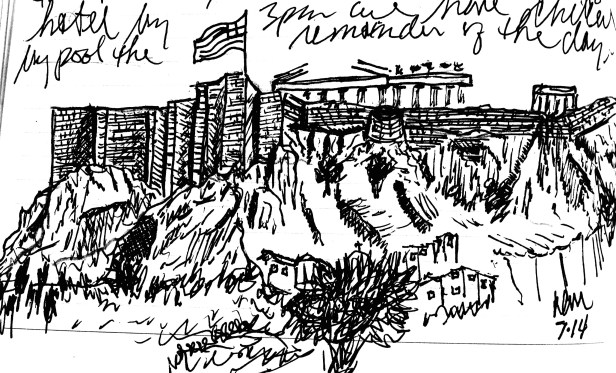
Sightseeing in the Plàka
Along about 5:30 p.m., we headed out for our sightseeing in the Plàka neighborhood. It was still hot and we stuck to the shady sides of the streets as we wound through the shopping streets, narrow lanes, past Byzantine-era churches, and the tourist oriented shops.
Ermou Street
Ermou is the main street leading from Sytagma Square into the Plàka. It once was filled with filth, loud traffic, and ugly signs. Since 2000, it has become a pedestrian-only area and both tourists and locals enjoys a stroll in this shopping oriented street.

Ermou Street
The Church of Kapnikarea
Athens was once a part of the vast Byzantine Empire which controlled much of Europe from A.D. 323-1453. This church, the Church of Kapnikarea, is a classic example of an 11th century Byzantine house of worship. Notice the classic Byzantine architectural designs including a red-tiled domed cupola topped with a cross and narrow and tall arched windows often with diamond-shaped trim.
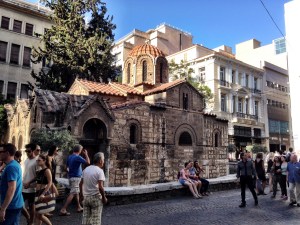
The Church of Kapnikarea
Athen’s Cathedral
This church was built in 1842 and looks much worst for wear than other churches in the area dating from 600 years before! However, it is Athen’s most important Greek Orthodox church and the “head” church of the Greek Orthodox faith. It is in dismal condition! The interior and exterior are covered with scaffolding and shrouded in construction cloth. The placard outside does list a schedule of worship services… but ughh… I can’t imaging it here.

Athens Cathedral
Adrianou Street
This IS souvenir street! Adrianou Street runs from near the new Acropolis Museum, heads north, and then turns west to follow the lays of the Acropolis hill. For me, it is the “main drag” offering all the “Greek” trinkets and souvenirs. You’ll find it all… olive oils, olive wood, worry beads, jewelry, leather sandals, sponges, Pandora beads, Greek replica statues, t-shirts, and tons of stray cats!
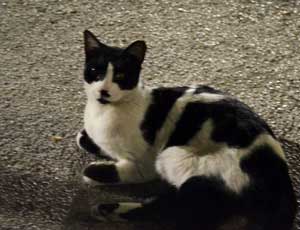
Hello kitty
The Roman Forum and Tower of the Winds
The Romans conquered Greek about 150 B.C. and set up their own “Roman”-ized way of life. The Greek Agora (I’ll address that later) became a marble “boneyard” from which the “Roman” Athens was built. Now-a-days, this area is often called the Roman Agora, but the Roman’s called it the Forum. Like in Rome, it was the commercial center of the city. A place to shop, meet, see and be seen.
Much later, the Ottomans converted this area into a bazaar. There is a mosque here in the area, although its minarets were decapitated by the Greeks when they won their independence from the Ottomans in the 1800’s.

Roman Forum & Tower of the Winds
Notice also the eight-sided domed tower known as the “Tower of the Winds.” This tower was built in the 1st century B.C. and contains a clock, a guide to the planets, and a weathervane. The carved figures depict the “winds” as winged humans who fly in and bring the weather. Don’t bother asking anyone about the meaning of the eight ancient Greek symbols for the “winds.” I’ve found everyone makes up their own story… even the guides!
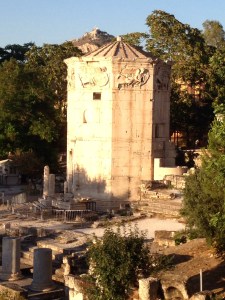
Tower of the Four Winds
Library of Hadrian
Hadrian was the Roman emperor in the 2nd century A.D. who had quite an affection for all things Greek. He had this library and civic center constructed for the Athenians. The building housed gardens, lecture halls, art galleries, and a library. Today, most of what you see is a reconstruction of one wall and a few Corinthian columns.

Library of Hadrian
Monastiraki Square
This is Athen’s second main city square loaded with old world class and style. The big building on the left is the metro station where tw0 train lines connect. From this square one could walk to the Archaeological Museum (1 mile to Omonia Square), feast on souvlaki (the typical Greek meat-on-a-stick fast food), wander into the old town, or or hop on the metro to zip off to far flung areas of town.

Monastiraki Square
By 7 p.m. we had experienced and seen the most important ancient and tourist sights in the Pàlka. Arriving at Monastriki Square and the Metro station, we decided to give the Ancient Agora a go. Following the Metro tracks, we soon came to the main Agora entrance and ticket booth.
Here’s a hint
Avoid long lines at archeological site ticket booths by arriving late in the afternoon. Alternatively, visit a lesser-known site entrance before the Acropolis. Purchase a €12 “strip ticket” for all the archeological sites in Athens including the Acropolis, Agora, Roman Forum, Keremikos Cemetery, Library of Hadrian, Theatre of Dionysus, and the Temple of Olympian Zeus. The ticket is valid for four days, and technically the attendant will tear off one “strip” for each site you visit. However, I did not have any collected except at the Acropolis. IF you purchase your ticket first at the Acropolis, then you’ll receive one ticket with a bar code that will be scanned at each site visited.

The Ancient Agora
Visiting the Ancient Agora during its final hour of the day was a good idea. Although the sun was still high and warm, there were only a few tourists milling around. We were able to see almost all the Agora sites in less than an hour, although it was a push to get up to the Temple of Hephaistos before the attendants began blowing their whistles to alert of the impending closing time of 8:00 p.m.
Temple of Hephaistos
This is one of the most well preserved of all Greek temples. Construction began here in 450 B.C. shortly after the entire Agora was destroyed by the invading Persians (480 B.C.). However, construction work stopped here while the Athenians concentrated on building the temples on the Acropolis, including the Parthenon. The temple is dedicated to Hephaistos, the “blacksmith” god and originally contained bronze statues of he and Athena.

Temple of Hephaistos
The temple was converted to a Christian church in 1300 A.D. and named the Church of St. George (the patron saint of Athens). Because of its continued use, the structure was maintained and kept up resulting in the wonderful condition in which we find it today.
The Agora in 1977
My notes, dated May 5, 1977, mention visiting the Temple of Hephaistos…
I got up at 6:15 am yesterday morning and walked down to the Temple of Zeus and took photos, then went to the Olympic Stadium and Royal Gardens. Doug and I then went and ate breakfast at the hotel. Then took an excursion to the ancient agora and the Theseion/Temple of Hephaistos and agora museum.
Here is the photo my friend Doug snapped of me standing in the temple. I recall back then we were allowed inside the temple and could actually see the ancient frieze in the alcoves depicting mythological battles between the Lapith tribe and a group of centaurs during a wedding feast.

Temple of Hephaistos 1977
Here is a photo Charlotte snapped of me in December 2010 during our visit to Athens. The temple has remained the same, I’ve not! Notice too that I was not allowed on the steps as the entire temple is fenced off.

Temple of Hephaistos 2010
Take the back gate for a speedy exit
We exited the Agora at the “back gate” up the hill in the direction of the Acropolis (Polygnotou “street” on your map). This put us up near the top (Prytaniou street) with great views of the Plàka and Athens to the north and the Acropolis looming just overhead to the south. We experienced a fantastic sunset and later, an almost full moon rising in the west.

Sunset over the Roman Forum
The Plàka is not flat.
It stretches consistently uphill until the slops of the Acropolis makes it impossible to build houses. Consequently, the “streets” are often no more than small cobbled pedestrian paths winding past shops, restaurants, and businesses. The farther uphill one wanders, the more steps and stairs are encountered.
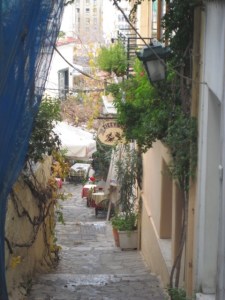
Steps and more steps
One such place, called Mnisikleous, is known for a series of cobbled stairs stretching of 100 yards and lined with trendy restaurants offering good food, decent drinks, ok music, and plenty of ambience.
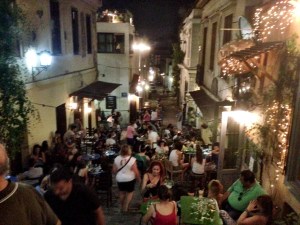
Mnisikleous Street dining
Capping off our day, we chose an outdoor restaurant known for authentic Greek food offered at very reasonable prices. Xenious Zeus is not a secret among tourist in Athens. This restaurant appears in all the guidebooks and is advertised as a place with good food and good prices. Since we were all the way up the hill, I thought we should give it a try.

.
For €12 we got a three-course meal featuring a selection of five Greek appetizers, called mezedes, a main course, and desert. We added a Greek Salad to share between the three of us. For a quick and unpretentious introduction to Greek cuisine, this place can’t be beat.

mezedes sampler
After dinner, we walked back to our hotel with a full moon rising in the west, our bellies full, and our bodies worn out. For me, this was the perfect mix of recovery, sightseeing, and dining to begin our adventures in Greece.
Read my previous post. Read my next post.

by David McGuffin | Jul 25, 2014 | Destinations
Christmas Markets in Europe
Christmas Markets spice up the winter holiday season with an extra dose of spirit and cheer. Outdoor markets celebrating Advent and the Christ child pop up in many towns from the first weekend in December right up until Christmas Eve. In German speaking regions they are known as Christkindl Markt or Weihnachtsmarkt. Our English translation is “Christ Child Market” and “Christmas Market.” However, they are not limited solely to Germany and Austria… Christmas Markets are a longtime tradition in many areas associated with the spread of Christianity in Europe under the guidance of the medieval church and the Holy Roman Empire.
My first experience at a Christmas Market
I fell in love with the “Christmas Market experience” several years ago when Charlotte and I visited Vienna and Prague. We had some airline miles to use before the end of the year, so we took off for a winter escape from the Florida heat. My luggage (and heavy winter coat) had been “lost” in flight, so my first experience was walking around Vienna’s markets in nothing but a thin cotton blazer. I assure you I had my fair share of glüwein trying to keep warm that night! I was impressed with the focus on Christmas and Christ, the hand-made unique crafts, and the general festive atmosphere.
Later, we visited Prague and experienced some of the most amazing foods. Locals were roasting huge hams on spits over open wood fires. All you had to do was walk up and they would whack off a piece, slap it on a slice of crusty bread and hand it to you. Many towns specialize in their own variety of sausages, sweets, breads, and chocolate covered treats. I can promise you’ll not go hungry! There is a fair amount of drinking too. Countless local varieties of glüwein (a piping hot mulled wine), pünsch, kinderpüncsh, schnapps, hot chocolate, and coffee are available and served in their own souvenir cup representing the Christmas Market and year.
All this, combined with chilly weather, caroling choirs, brass bands, millions of lights, and festive decorations are sure to supercharge your holiday travel experience. It is totally different traveling in the winter and being immersed in the Christmas cheer. Even if you’ve visited these destinations before in the spring or summer… this winter Christmas Market experience is like making it all fresh and new again.
Why not join us?
This year, why don’t you join me in experiencing the Christmas Markets of Germany and Austria? I guarantee you’ll catch the Christmas spirit, get in some fine shopping, eat well, experience the sights, and still be home in time to celebrate Christmas with your usual traditions.
We leave the USA on December 6 and return December 14. A few seats are still available and we are keeping one warm for you!
Merry Christmas,

See the tour itinerary, get more details, and sign-up.
Watch a video slideshow featuring all my Christmas Market destinations.

 I was reminded that today is the 25th anniversary of the FALL OF THE BERLIN WALL. Many recall hearing of the Wall and its 28 year history of separating East and West Berlin. You may also remember listening to news reports of the events leading up to its fall on November 9, 1989.
I was reminded that today is the 25th anniversary of the FALL OF THE BERLIN WALL. Many recall hearing of the Wall and its 28 year history of separating East and West Berlin. You may also remember listening to news reports of the events leading up to its fall on November 9, 1989.








 FEATURED SLIDE SHOW
FEATURED SLIDE SHOW
 GIVE ME A REVIEW ON FACEBOOK
GIVE ME A REVIEW ON FACEBOOK





















